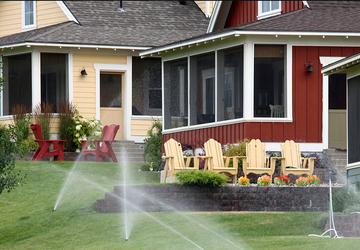Maintaining a lush, green lawn is a goal for many homeowners, but it often comes at the cost of significant water usage. As the importance of water conservation grows, it's time to rethink our lawn care practices. The good news is that you can have a beautiful lawn and save water simultaneously. By making some simple changes and adopting smart lawn care techniques, you can enjoy a vibrant lawn while reducing your water bill and environmental impact.
In this article, we'll delve into our top 10 water-saving tips for your lawn. These practical tips are easy to implement and help maintain a healthy lawn while being eco-conscious.
1. Choose the Right Grass
Selecting the appropriate grass type for your region can improve your lawn's water needs. Opt for drought-tolerant varieties like Bermuda grass, Zoysia grass, or Buffalo grass.
These grasses are adapted to thrive with less water and can withstand dry spells better than traditional lawn varieties. By choosing the right grass, you're setting the stage for water efficiency right from the beginning.
2. Adjust Your Mowing Habits
Surprisingly, how you handle your lawn mower can significantly impact your lawn's water demands. Raise those lawnmower blades a notch to leave your grass a tad longer. Longer grass provides some shade to the soil, which cuts down on evaporation and assists the soil in retaining moisture.
It's a double win because it promotes healthier root growth, allowing your lawn to tap into water more efficiently. So, let your grass grow a little taller – it's a simple trick for a greener, more water-efficient lawn.
3. Water Early in the Morning
When you water your lawn, it can make a world of difference. Aim to water your lawn early in the morning before the sun cranks its heat. This strategy reduces water loss through evaporation and ensures the moisture gets deep into the soil where it's needed most.
While evening watering might seem like a good idea, it can create prolonged moisture on your lawn, potentially inviting diseases. So, set your sprinklers to kick in during the morning to make the most of your water and keep your lawn healthy.
4. Invest in a Smart Sprinkler System
Modern technology has worked wonders in lawn care, offering convenient ways to conserve water while maintaining a lush lawn. Consider investing in a smart sprinkler system that adjusts its watering schedules based on real-time weather conditions and soil moisture levels.
These systems act like your lawn caretaker, ensuring your lawn receives the right amount of water it needs to thrive. Say goodbye to overwatering and hello to a smarter, water-efficient lawn care approach!
5. Collect Rainwater
Mother Nature often provides us with a generous supply of free water, so why not put it to good use? Install a rain barrel beneath your roof's downspouts to collect rainwater. This harvested rainwater can water your lawn and garden, reducing your reliance on tap water. It's a sustainable approach that benefits both your wallet and the environment.
Additionally, using rainwater reduces your carbon footprint by decreasing the energy required to treat and transport water from distant sources, contributing to a greener planet.
6. Use Mulch Around Trees and Shrubs
Mulch isn't just for aesthetics; it's a multitasking hero in your garden. Spread a layer of mulch around trees, shrubs, and flower beds to reduce water evaporation and maintain soil temperature. This simple practice can help your landscaping plants thrive with less water, creating an eco-friendly and visually appealing water-efficient outdoor space.
Furthermore, mulch provides a protective barrier against weeds, reducing competition for water and nutrients, and it gradually breaks down to improve the soil's fertility, enhancing the overall health of your garden ecosystem.
7. Fix Leaks and Broken Sprinklers
Even a small drip or a malfunctioning sprinkler system can lead to significant water wastage over time. Regularly inspect your irrigation system for leaks or issues and address them promptly. By taking this simple step, you'll not only save money on your water bill but also contribute to water conservation. It's a win-win!
Remember, a minor leak today can translate into gallons of wasted water tomorrow, which not only affects your wallet but also strains our local water resources. So, grab that wrench and make a difference, one drop at a time!
8. Embrace Drought-Tolerant Plants
Diversity is key to creating a water-efficient landscape. Consider adding drought-tolerant plants to your garden and landscaping. These plants are adapted to thrive in arid conditions and require minimal watering.
Succulents, lavender, yarrow, and ornamental grasses are excellent choices for a water-wise garden. By incorporating these plants, you can reduce the overall water demands of your outdoor space while adding beauty and variety.
9. Aerate Your Lawn
When your soil becomes too compacted, it can create problems with water absorption, causing runoff and wasting valuable water resources. To enhance water penetration into the soil, consider lawn aeration, which involves perforating your lawn with small holes.
You can rent an aerator or enlist the services of a professional to carry out this task. This way, your lawn can make the most of every precious drop of water. Think of aeration as giving your lawn a breath of fresh air. This process not only enhances water retention but also facilitates the delivery of nutrients to the roots.
10. Monitor Soil Moisture
Avoid guesswork when determining when to water your lawn. Instead, use a soil moisture sensor or the straightforward screwdriver test. Push a screwdriver into the soil. If it slides in easily, your lawn doesn't need water yet. If you encounter resistance, it's time to water. This hands-on approach ensures you're not watering your lawn prematurely, preventing water wastage and promoting efficient water use.
Monitoring soil moisture levels also helps you fine-tune your watering schedule, ensuring your lawn receives the right hydration to thrive without excess water runoff or waste.
Conclusion
You can have a thriving, green lawn without draining precious water resources. By incorporating these ten water-saving tips into your lawn care routine, you can enjoy a healthy lawn while reducing your water bill and environmental impact. From choosing the right grass to adjusting mowing habits and embracing technology, there are numerous ways to conserve water. Take action today to create a lawn that's both green and eco-friendly.




